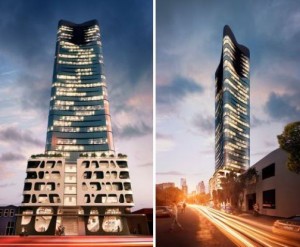
CLOSE TO CBD: “Thistlethwaite”, a 38-storey tower with 291 apartments designed by Rothelowman Architects, has been given the green light for construction at 15-35 Thistlethwaite St, South Melbourne, in the Montague Precinct. Picture: ROTHELOWMAN
Progress at Fishermans Bend is moving along steadily. More than $2billion of development has already been approved at Fishermans Bend, allowing more people to live closer to Melbourne’s CBD.
Another $2.68billion of projects are being assessed.
Progress has been steady. Since January 2014, 20 high-rise towers of between 20 and 49 storeys in Fishermans Bend have been approved.
Applications for another 26 towers of between 20 and 64 storeys have been received, up to June 30, 2015.
The towers are all residential buildings and offer the potential for about 17,600 apartments. Of these, about 6700 have approval. Most are in the Montague Precinct, next to Southbank.
In contrast, 5300 Docklands apartments have built in the past 20 years.
In the past, Fishermans Bend land has mostly been used for industrial and commercial purposes. The style of existing buildings is mostly industrial with some heritage stock.
Most of the land is privately owned. A number of small parcels dot Montague while the rest of the area has larger sites.
In July 2015, General Motors Holden put a 37ha portion of its land in the Employment Precinct on to the market.
The range of opportunities Fishermans Bend affords Melbourne and Victoria is huge.
The area offers affordable, developable land close to the CBD, a key competitive advantage for Melbourne.
Montague, in particular, will offer attractive office space for the creative sector and high-end service industries that are boosting employment in Melbourne.
The renewal of Fishermans Bend will allow for greater residential growth, paving the way for more people to live closer to Melbourne’s CBD.
An increase in housing supply may also lead to possible affordability initiatives.
Over the next 40 years, Melbourne’s population is expected to grow from 4.1 million to 6.5 million. It is thought the city will eventually overtake Sydney as Australia’s most populated city.
This growth has led to land prices rising in the inner city, driving population growth to the middle and outer suburbs.
Fishermans Bend will provide an unparalleled opportunity for people of all ages to live closer to existing jobs, services, public spaces and transport connections.
